Teaching english idioms of happiness and sadness through conceptual metaphors in Vietnamese context
Idioms are usually defined as groups of
words whose meaning cannot be inferred from
the meanings of their individual words
(Kövecses, 2002). They include metaphors,
metonymies, similes, phrasal verbs, and
others. These expressions have been
extensively used in all spoken and written
genres of discourse (O’Dell and McCarthy,
2010); it was estimated that an English native
speaker may use approximately 20 million
idioms throughout his or her lifetime of 60
years (Cooper, 1998). Due to the substantial
number of idioms and their pervasive use,
lack of idiomatic knowledge can be a great
hindrance to EFL learners’ communication
with native speakers.
However, learning English idioms is not
an easy task. As Liu (2003) stated, idioms are
“notoriously difficult” to the learners of
English due to their “rather rigid structure,
quite unpredictable meaning and fairly
extensive use” (p.671). Moreover, idioms are
not only cross-linguistic but also crosscultural phenomena (Kövecses, 2002).
According to Cooper (1998), even students
with profound knowledge of grammar and
vocabulary still feel difficult to understand
and use idiomatic language if they are not
aware of the cultural diversity underlying
idioms.
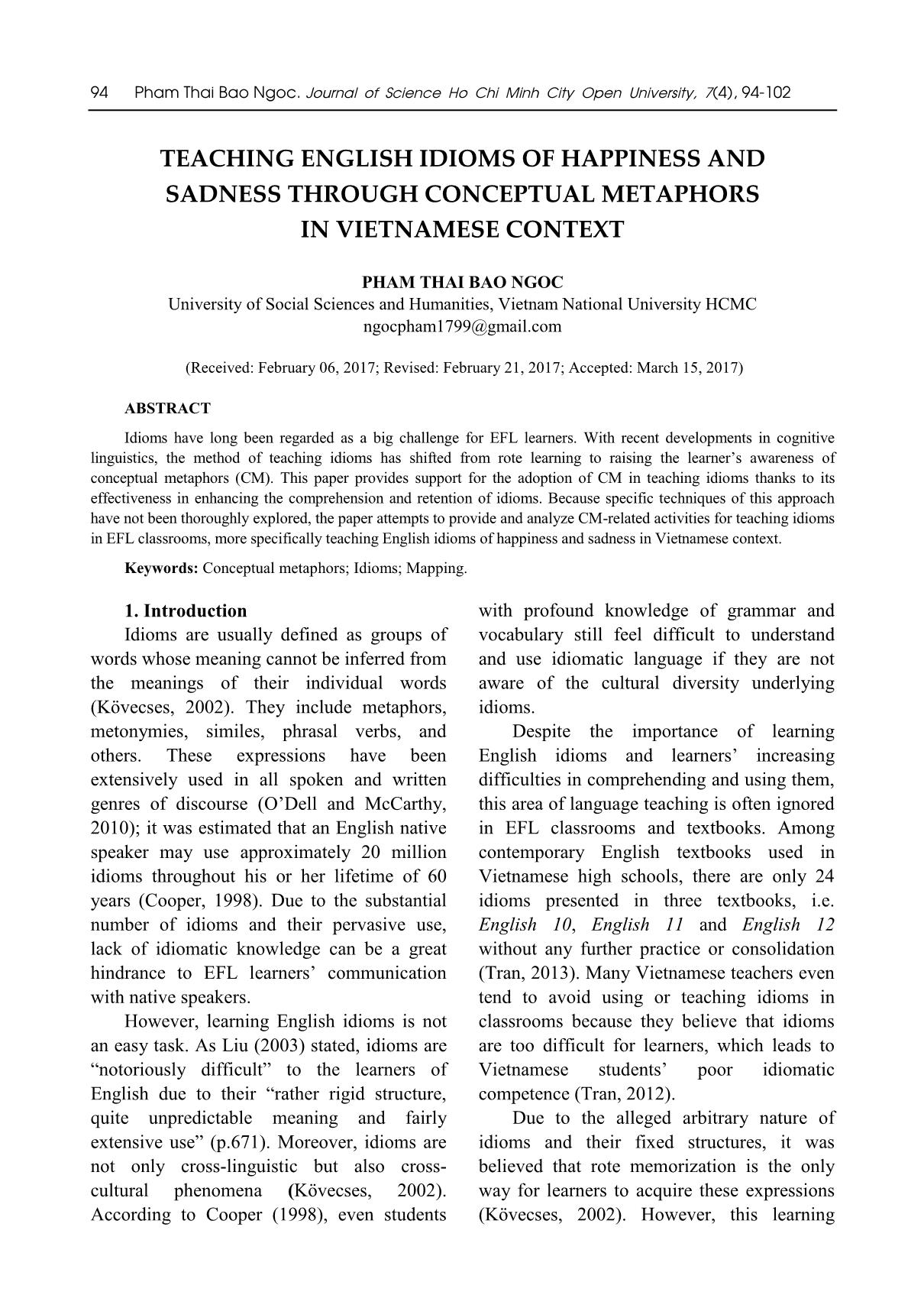
Trang 1
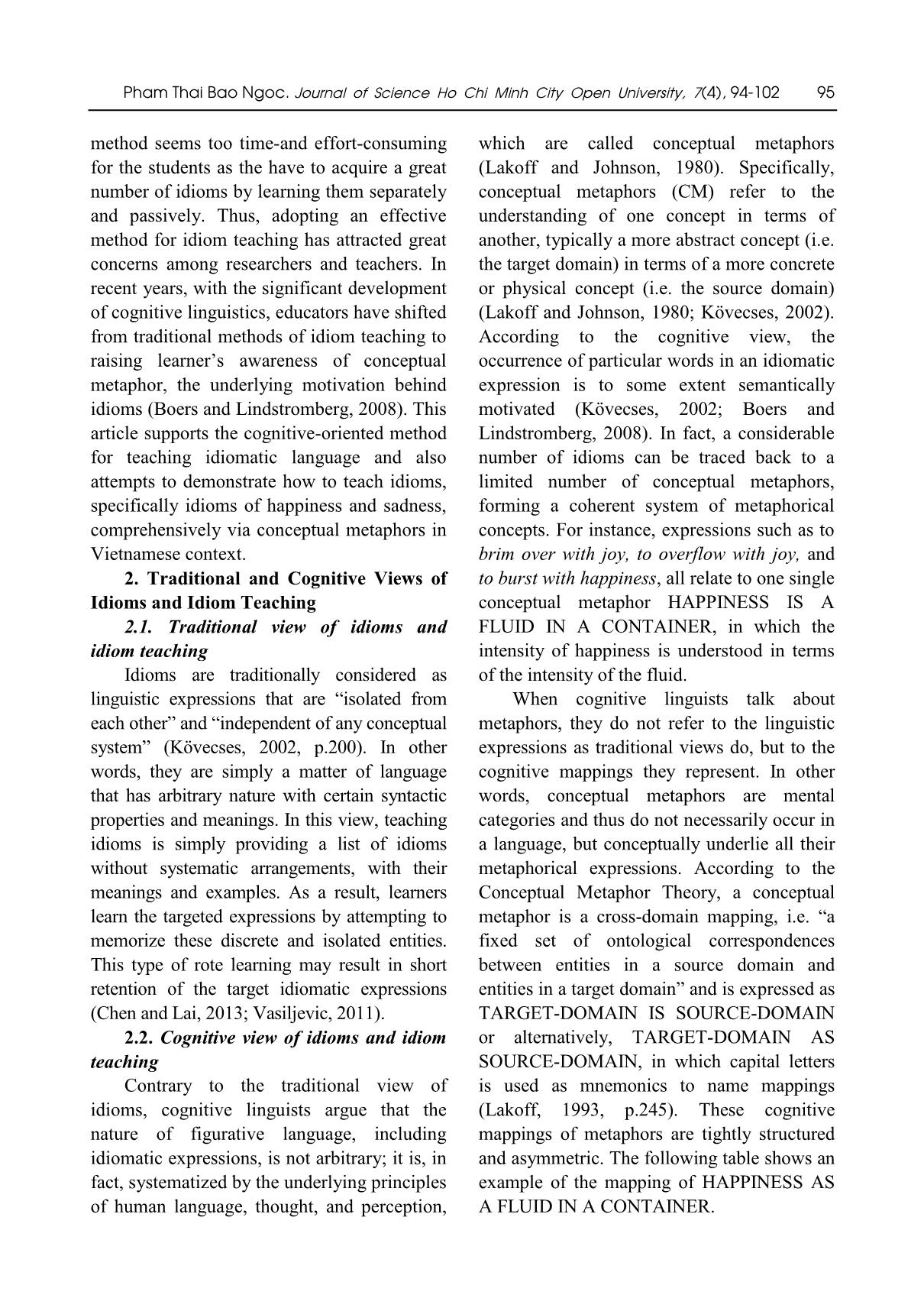
Trang 2
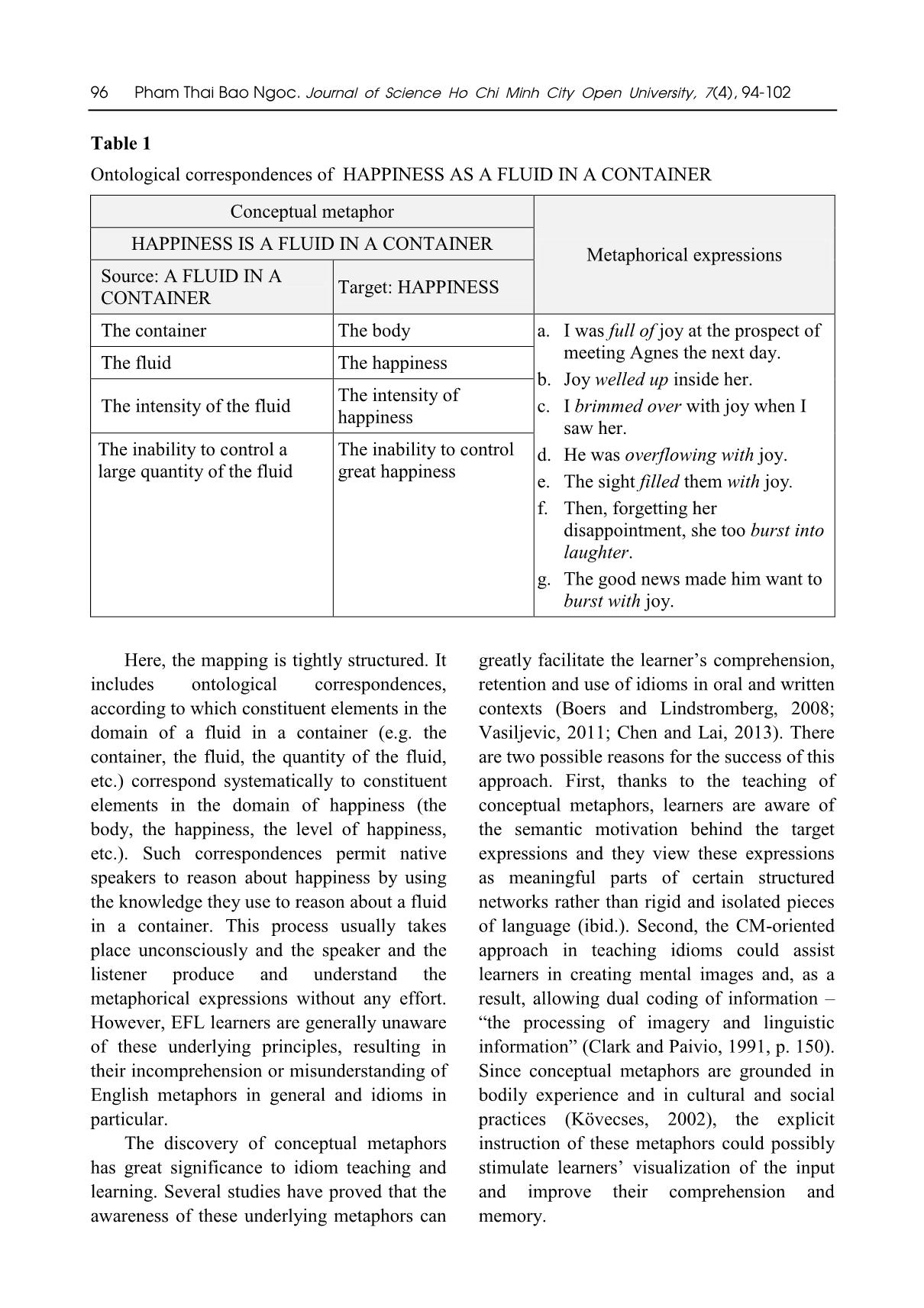
Trang 3
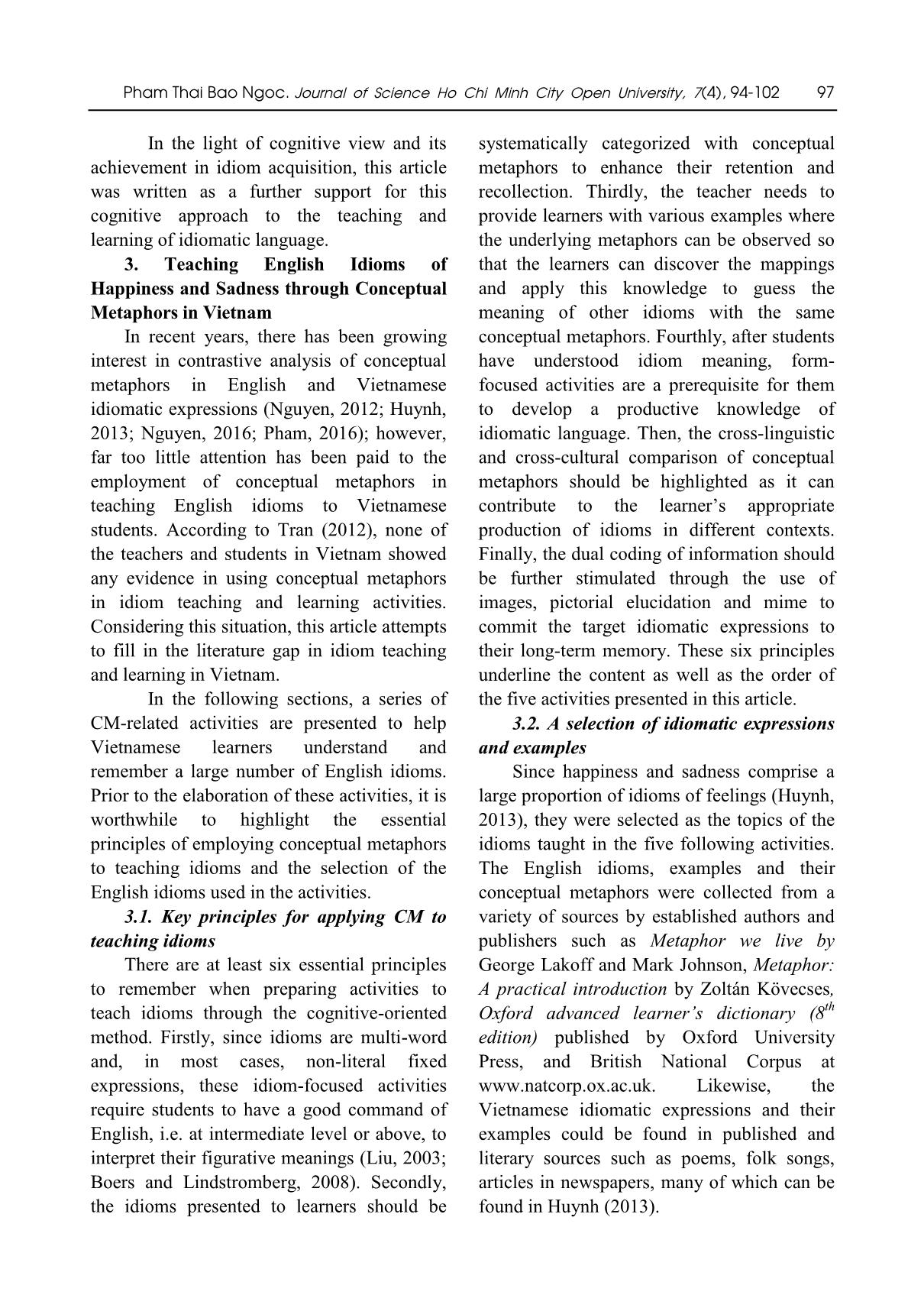
Trang 4
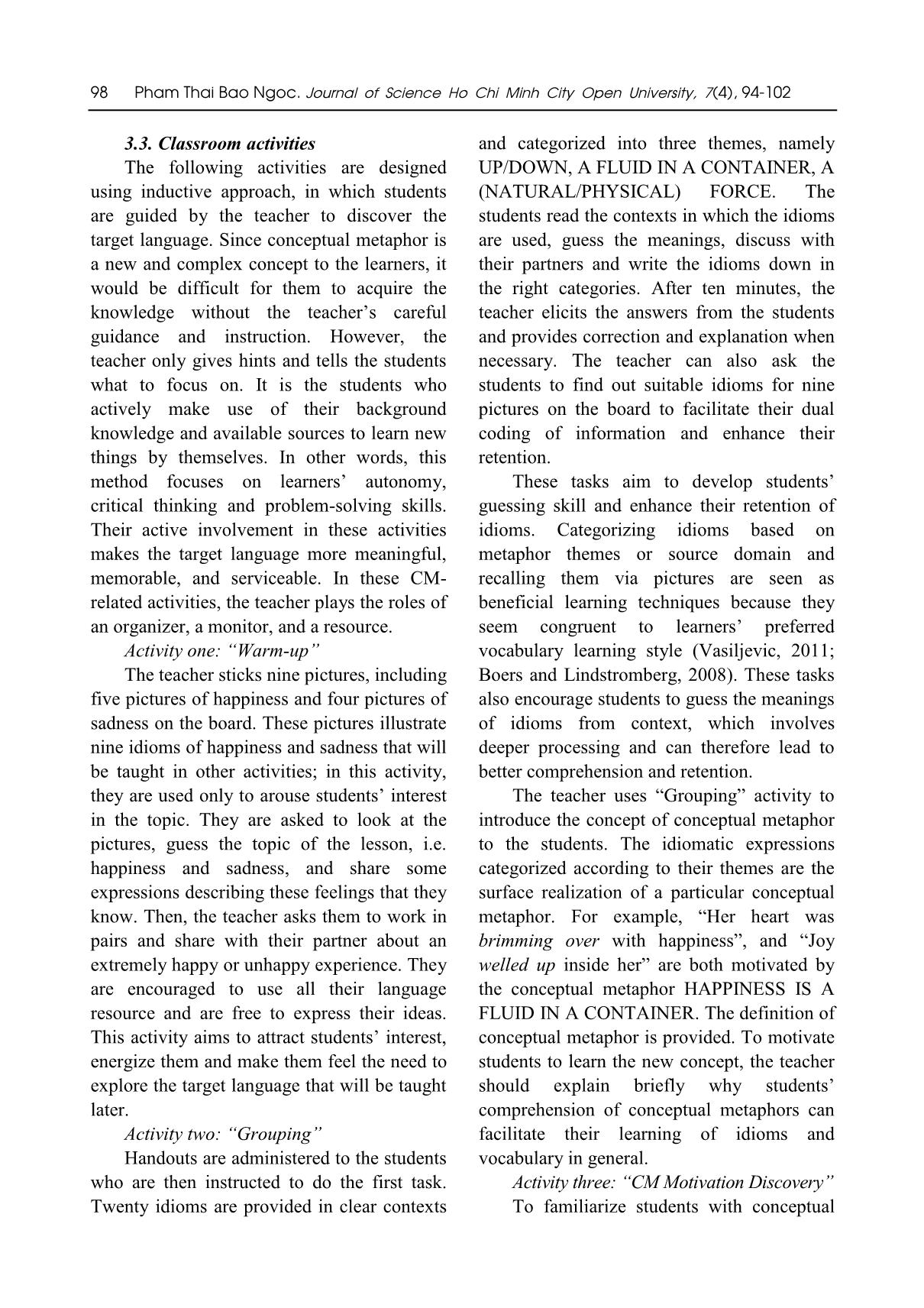
Trang 5
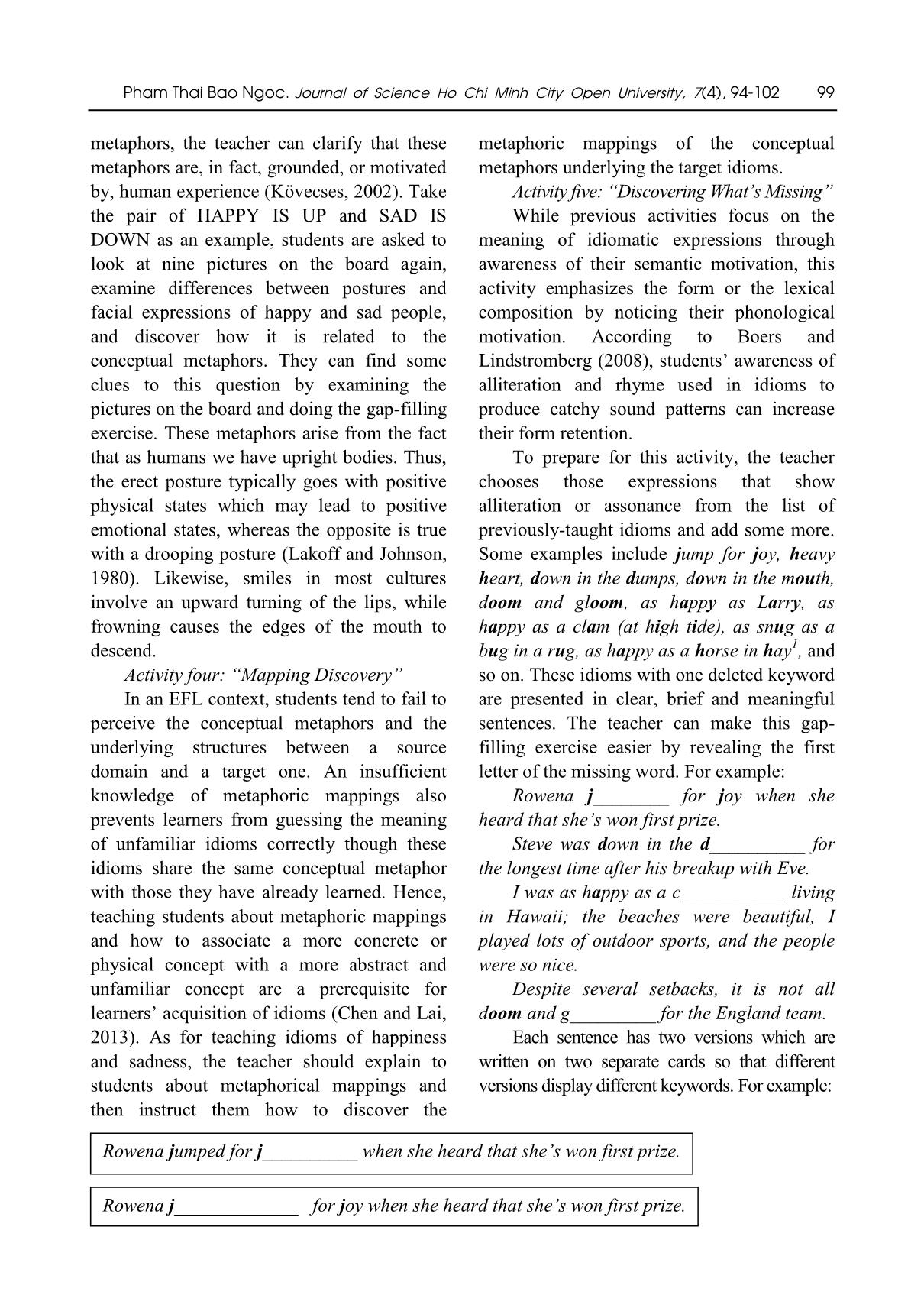
Trang 6
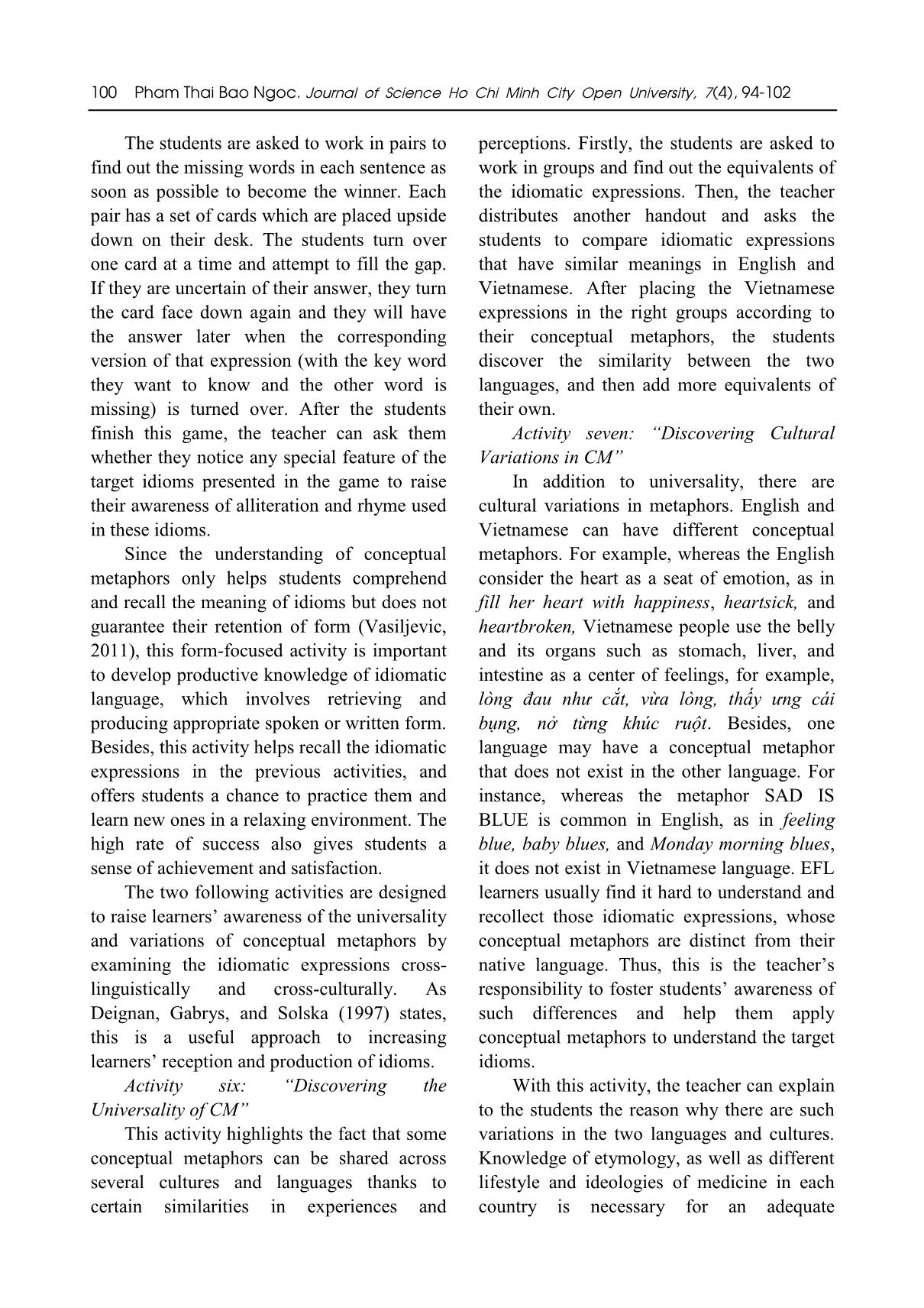
Trang 7
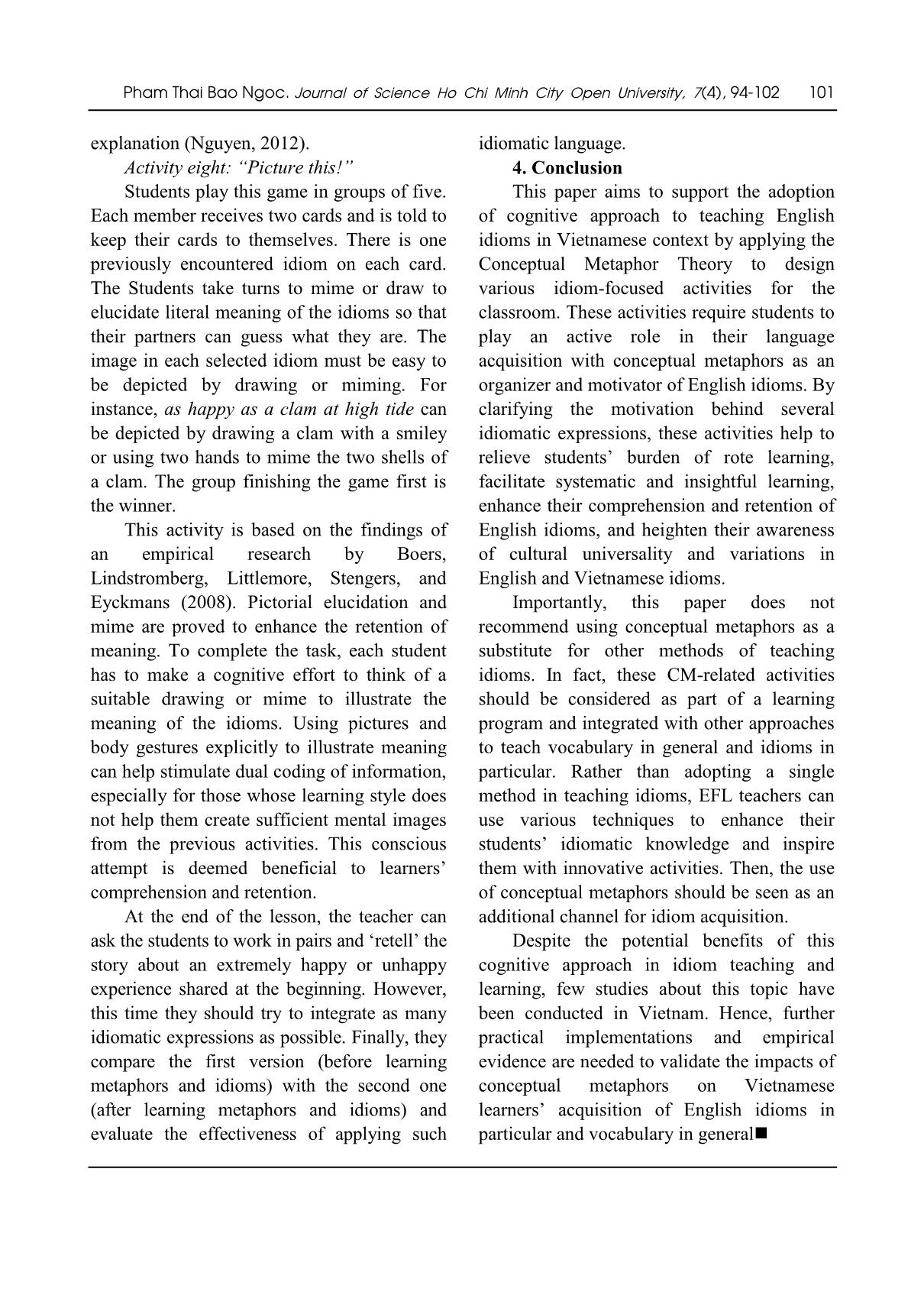
Trang 8

Trang 9
Tóm tắt nội dung tài liệu: Teaching english idioms of happiness and sadness through conceptual metaphors in Vietnamese context

94 Pham Thai Bao Ngoc. Journal of Science Ho Chi Minh City Open University, 7(4), 94-102 TEACHING ENGLISH IDIOMS OF HAPPINESS AND SADNESS THROUGH CONCEPTUAL METAPHORS IN VIETNAMESE CONTEXT PHAM THAI BAO NGOC University of Social Sciences and Humanities, Vietnam National University HCMC ngocpham1799@gmail.com (Received: February 06, 2017; Revised: February 21, 2017; Accepted: March 15, 2017) ABSTRACT Idioms have long been regarded as a big challenge for EFL learners. With recent developments in cognitive linguistics, the method of teaching idioms has shifted from rote learning to raising the learner’s awareness of conceptual metaphors (CM). This paper provides support for the adoption of CM in teaching idioms thanks to its effectiveness in enhancing the comprehension and retention of idioms. Because specific techniques of this approach have not been thoroughly explored, the paper attempts to provide and analyze CM-related activities for teaching idioms in EFL classrooms, more specifically teaching English idioms of happiness and sadness in Vietnamese context. Keywords: Conceptual metaphors; Idioms; Mapping. 1. Introduction Idioms are usually defined as groups of words whose meaning cannot be inferred from the meanings of their individual words (Kövecses, 2002). They include metaphors, metonymies, similes, phrasal verbs, and others. These expressions have been extensively used in all spoken and written genres of discourse (O’Dell and McCarthy, 2010); it was estimated that an English native speaker may use approximately 20 million idioms throughout his or her lifetime of 60 years (Cooper, 1998). Due to the substantial number of idioms and their pervasive use, lack of idiomatic knowledge can be a great hindrance to EFL learners’ communication with native speakers. However, learning English idioms is not an easy task. As Liu (2003) stated, idioms are “notoriously difficult” to the learners of English due to their “rather rigid structure, quite unpredictable meaning and fairly extensive use” (p.671). Moreover, idioms are not only cross-linguistic but also cross- cultural phenomena (Kövecses, 2002). According to Cooper (1998), even students with profound knowledge of grammar and vocabulary still feel difficult to understand and use idiomatic language if they are not aware of the cultural diversity underlying idioms. Despite the importance of learning English idioms and learners’ increasing difficulties in comprehending and using them, this area of language teaching is often ignored in EFL classrooms and textbooks. Among contemporary English textbooks used in Vietnamese high schools, there are only 24 idioms presented in three textbooks, i.e. English 10, English 11 and English 12 without any further practice or consolidation (Tran, 2013). Many Vietnamese teachers even tend to avoid using or teaching idioms in classrooms because they believe that idioms are too difficult for learners, which leads to Vietnamese students’ poor idiomatic competence (Tran, 2012). Due to the alleged arbitrary nature of idioms and their fixed structures, it was believed that rote memorization is the only way for learners to acquire these expressions (Kövecses, 2002). However, this learning Pham Thai Bao Ngoc. Journal of Science Ho Chi Minh City Open University, 7(4), 94-102 95 method seems too time-and effort-consuming for the students as the have to acquire a great number of idioms by learning them separately and passively. Thus, adopting an effective method for idiom teaching has attracted great concerns among researchers and teachers. In recent years, with the significant development of cognitive linguistics, educators have shifted from traditional methods of idiom teaching to raising learner’s awareness of conceptual metaphor, the underlying motivation behind idioms (Boers and Lindstromberg, 2008). This article supports the cognitive-oriented method for teaching idiomatic language and also attempts to demonstrate how to teach idioms, specifically idioms of happiness and sadness, comprehensively via conceptual metaphors in Vietnamese context. 2. Traditional and Cognitive Views of Idioms and Idiom Teaching 2.1. Traditional view of idioms and idiom teaching Idioms are traditionally considered as linguistic expressions that are “isolated from each other” and “independent of any conceptual system” (Kövecses, 2002, p.200). In other words, they are simply a matter of language that has arbitrary nature with certain syntactic properties and meanings. In this view, teaching idioms is simply providing a list of idioms without systematic arrangements, with their meanings and examples. As a result, learners learn the targeted expressions by attempting to memorize these discrete and isolated entities. This type of rote learning may result in sho ... xplain briefly why students’ comprehension of conceptual metaphors can facilitate their learning of idioms and vocabulary in general. Activity three: “CM Motivation Discovery” To familiarize students with conceptual Pham Thai Bao Ngoc. Journal of Science Ho Chi Minh City Open University, 7(4), 94-102 99 metaphors, the teacher can clarify that these metaphors are, in fact, grounded, or motivated by, human experience (Kövecses, 2002). Take the pair of HAPPY IS UP and SAD IS DOWN as an example, students are asked to look at nine pictures on the board again, examine differences between postures and facial expressions of happy and sad people, and discover how it is related to the conceptual metaphors. They can find some clues to this question by examining the pictures on the board and doing the gap-filling exercise. These metaphors arise from the fact that as humans we have upright bodies. Thus, the erect posture typically goes with positive physical states which may lead to positive emotional states, whereas the opposite is true with a drooping posture (Lakoff and Johnson, 1980). Likewise, smiles in most cultures involve an upward turning of the lips, while frowning causes the edges of the mouth to descend. Activity four: “Mapping Discovery” In an EFL context, students tend to fail to perceive the conceptual metaphors and the underlying structures between a source domain and a target one. An insufficient knowledge of metaphoric mappings also prevents learners from guessing the meaning of unfamiliar idioms correctly though these idioms share the same conceptual metaphor with those they have already learned. Hence, teaching students about metaphoric mappings and how to associate a more concrete or physical concept with a more abstract and unfamiliar concept are a prerequisite for learners’ acquisition of idioms (Chen and Lai, 2013). As for teaching idioms of happiness and sadness, the teacher should explain to students about metaphorical mappings and then instruct them how to discover the metaphoric mappings of the conceptual metaphors underlying the target idioms. Activity five: “Discovering What’s Missing” While previous activities focus on the meaning of idiomatic expressions through awareness of their semantic motivation, this activity emphasizes the form or the lexical composition by noticing their phonological motivation. According to Boers and Lindstromberg (2008), students’ awareness of alliteration and rhyme used in idioms to produce catchy sound patterns can increase their form retention. To prepare for this activity, the teacher chooses those expressions that show alliteration or assonance from the list of previously-taught idioms and add some more. Some examples include jump for joy, heavy heart, down in the dumps, down in the mouth, doom and gloom, as happy as Larry, as happy as a clam (at high tide), as snug as a bug in a rug, as happy as a horse in hay 1 , and so on. These idioms with one deleted keyword are presented in clear, brief and meaningful sentences. The teacher can make this gap- filling exercise easier by revealing the first letter of the missing word. For example: Rowena j________ for joy when she heard that she’s won first prize. Steve was down in the d__________ for the longest time after his breakup with Eve. I was as happy as a c___________ living in Hawaii; the beaches were beautiful, I played lots of outdoor sports, and the people were so nice. Despite several setbacks, it is not all doom and g_________ for the England team. Each sentence has two versions which are written on two separate cards so that different versions display different keywords. For example: Rowena jumped for j__________ when she heard that she’s won first prize. Rowena j_____________ for joy when she heard that she’s won first prize. 100 Pham Thai Bao Ngoc. Journal of Science Ho Chi Minh City Open University, 7(4), 94-102 The students are asked to work in pairs to find out the missing words in each sentence as soon as possible to become the winner. Each pair has a set of cards which are placed upside down on their desk. The students turn over one card at a time and attempt to fill the gap. If they are uncertain of their answer, they turn the card face down again and they will have the answer later when the corresponding version of that expression (with the key word they want to know and the other word is missing) is turned over. After the students finish this game, the teacher can ask them whether they notice any special feature of the target idioms presented in the game to raise their awareness of alliteration and rhyme used in these idioms. Since the understanding of conceptual metaphors only helps students comprehend and recall the meaning of idioms but does not guarantee their retention of form (Vasiljevic, 2011), this form-focused activity is important to develop productive knowledge of idiomatic language, which involves retrieving and producing appropriate spoken or written form. Besides, this activity helps recall the idiomatic expressions in the previous activities, and offers students a chance to practice them and learn new ones in a relaxing environment. The high rate of success also gives students a sense of achievement and satisfaction. The two following activities are designed to raise learners’ awareness of the universality and variations of conceptual metaphors by examining the idiomatic expressions cross- linguistically and cross-culturally. As Deignan, Gabrys, and Solska (1997) states, this is a useful approach to increasing learners’ reception and production of idioms. Activity six: “Discovering the Universality of CM” This activity highlights the fact that some conceptual metaphors can be shared across several cultures and languages thanks to certain similarities in experiences and perceptions. Firstly, the students are asked to work in groups and find out the equivalents of the idiomatic expressions. Then, the teacher distributes another handout and asks the students to compare idiomatic expressions that have similar meanings in English and Vietnamese. After placing the Vietnamese expressions in the right groups according to their conceptual metaphors, the students discover the similarity between the two languages, and then add more equivalents of their own. Activity seven: “Discovering Cultural Variations in CM” In addition to universality, there are cultural variations in metaphors. English and Vietnamese can have different conceptual metaphors. For example, whereas the English consider the heart as a seat of emotion, as in fill her heart with happiness, heartsick, and heartbroken, Vietnamese people use the belly and its organs such as stomach, liver, and intestine as a center of feelings, for example, lòng đau như cắt, vừa lòng, thấy ưng cái bụng, nở từng khúc ruột. Besides, one language may have a conceptual metaphor that does not exist in the other language. For instance, whereas the metaphor SAD IS BLUE is common in English, as in feeling blue, baby blues, and Monday morning blues, it does not exist in Vietnamese language. EFL learners usually find it hard to understand and recollect those idiomatic expressions, whose conceptual metaphors are distinct from their native language. Thus, this is the teacher’s responsibility to foster students’ awareness of such differences and help them apply conceptual metaphors to understand the target idioms. With this activity, the teacher can explain to the students the reason why there are such variations in the two languages and cultures. Knowledge of etymology, as well as different lifestyle and ideologies of medicine in each country is necessary for an adequate Pham Thai Bao Ngoc. Journal of Science Ho Chi Minh City Open University, 7(4), 94-102 101 explanation (Nguyen, 2012). Activity eight: “Picture this!” Students play this game in groups of five. Each member receives two cards and is told to keep their cards to themselves. There is one previously encountered idiom on each card. The Students take turns to mime or draw to elucidate literal meaning of the idioms so that their partners can guess what they are. The image in each selected idiom must be easy to be depicted by drawing or miming. For instance, as happy as a clam at high tide can be depicted by drawing a clam with a smiley or using two hands to mime the two shells of a clam. The group finishing the game first is the winner. This activity is based on the findings of an empirical research by Boers, Lindstromberg, Littlemore, Stengers, and Eyckmans (2008). Pictorial elucidation and mime are proved to enhance the retention of meaning. To complete the task, each student has to make a cognitive effort to think of a suitable drawing or mime to illustrate the meaning of the idioms. Using pictures and body gestures explicitly to illustrate meaning can help stimulate dual coding of information, especially for those whose learning style does not help them create sufficient mental images from the previous activities. This conscious attempt is deemed beneficial to learners’ comprehension and retention. At the end of the lesson, the teacher can ask the students to work in pairs and ‘retell’ the story about an extremely happy or unhappy experience shared at the beginning. However, this time they should try to integrate as many idiomatic expressions as possible. Finally, they compare the first version (before learning metaphors and idioms) with the second one (after learning metaphors and idioms) and evaluate the effectiveness of applying such idiomatic language. 4. Conclusion This paper aims to support the adoption of cognitive approach to teaching English idioms in Vietnamese context by applying the Conceptual Metaphor Theory to design various idiom-focused activities for the classroom. These activities require students to play an active role in their language acquisition with conceptual metaphors as an organizer and motivator of English idioms. By clarifying the motivation behind several idiomatic expressions, these activities help to relieve students’ burden of rote learning, facilitate systematic and insightful learning, enhance their comprehension and retention of English idioms, and heighten their awareness of cultural universality and variations in English and Vietnamese idioms. Importantly, this paper does not recommend using conceptual metaphors as a substitute for other methods of teaching idioms. In fact, these CM-related activities should be considered as part of a learning program and integrated with other approaches to teach vocabulary in general and idioms in particular. Rather than adopting a single method in teaching idioms, EFL teachers can use various techniques to enhance their students’ idiomatic knowledge and inspire them with innovative activities. Then, the use of conceptual metaphors should be seen as an additional channel for idiom acquisition. Despite the potential benefits of this cognitive approach in idiom teaching and learning, few studies about this topic have been conducted in Vietnam. Hence, further practical implementations and empirical evidence are needed to validate the impacts of conceptual metaphors on Vietnamese learners’ acquisition of English idioms in particular and vocabulary in general 102 Pham Thai Bao Ngoc. Journal of Science Ho Chi Minh City Open University, 7(4), 94-102 Note 1 The expressions such as as happy as a clam (at high tide), as snug as a bug in a rug, and as happy as a horse in hay are surface realization of the conceptual metaphor A HAPPY PERSON IS AN ANIMAL (THAT LIVES WELL). (Kövecses, 2002). References Boers, F. & Lindstromberg, S. (2008). Applications of cognitive linguistics: Cognitive linguistic Approaches to teaching vocabulary and phraseology. Berlin: Mouton de Gruyter. Boers, F., Lindstromberg, S., Littlemore, J., Stengers, H. and Eyckmans, J. (2008). Variables in the mnemonic effectiveness of pictorial elucidation. In F. Boers & S. Lindstromberg (Eds.), Cognitive linguistic Approaches to teaching vocabulary and phraseology (pp.189-218). Berlin: Mouton de Gruyter. Chen, Y. & Lai, H. (2013). Teaching English idioms as metaphors through cognitive-oriented methods: A case in an EFL writing class. English Language Teaching, 6(6), 13-20. Clark, J. M., & Paivio, A. (1991). Dual coding theory and education. Educational Psychology Review, 3(3), 149-210. Cooper, C.T. (1998). Teaching idioms. Foreign Language Annals, 31(2), 255-266. Deignan, A., Gabrys, D, & Solska, A. (1997). Teaching English metaphors using cross-linguistic awareness-raising activities. ELT Journal, 51(4), 352-360. Huynh, T. M. N. (2013). An investigation into conceptual metaphors used for describing happiness and sadness in English and Vietnamese (Unpublished master’s thesis). Danang: University of Danang. Kövecses, Z. (2002). Metaphor: A practical introduction. Oxford: Oxford University Press. Lakoff, G. (1993). The contemporary theory of metaphor. In A. Ortony (Ed.), Metaphor and thought (2 nd ed.), (pp. 202-251). Cambridge: Cambridge University Press. Lakoff, G. & Johnson, M. (1980). Metaphors we live by. Chicago & London: The University of Chicago Press. Liu, D. (2003). The most frequently used spoken American English idioms: a corpus analysis and its implications. TESOL Quarterly, 37(4), 671-700. Nguyen, N. V. (2016). Conceptual metaphor about personality in English and Vietnamese idioms of body parts. Tạp chí Khoa học Đại học Sư phạm TPHCM, 2(80), 5-11. Nguyen, T. H. (2012). English idioms containing the word “heart” and its synonyms in Vietnamese idioms: a contrastive analysis from cultural perspectives (Unpublished master’s thesis). Hanoi: Vietnam National University. O’Dell, F. & McCarthy, M. (2010). English idioms in use (Advanced). Cambridge: Cambridge University Press. Pham, H. P. Q. (2016). A contrastive analysis of the conceptual metaphor “ideas are food” in English and Vietnamese. Tạp chí Khoa học Đại học Sư phạm TPHCM, 2(80), 12-21. Tran, H. Q. (2012). An explorative study of idiom teaching for pre-service teachers of English. English Language Teaching, 5 (12), 76-86. Tran, H. Q. (2013). Figurative idiomatic competence: An analysis of EFL learners in Vietnam. Language Education in Asia, 4 (1), 23-38. Vasiljevic, Z. (2011). Using Conceptual Metaphors and L1 Definitions in Teaching Idioms to Non-native Speakers. The Journal of Asia TEFL, 8(3), 135-160.
File đính kèm:
 teaching_english_idioms_of_happiness_and_sadness_through_con.pdf
teaching_english_idioms_of_happiness_and_sadness_through_con.pdf

